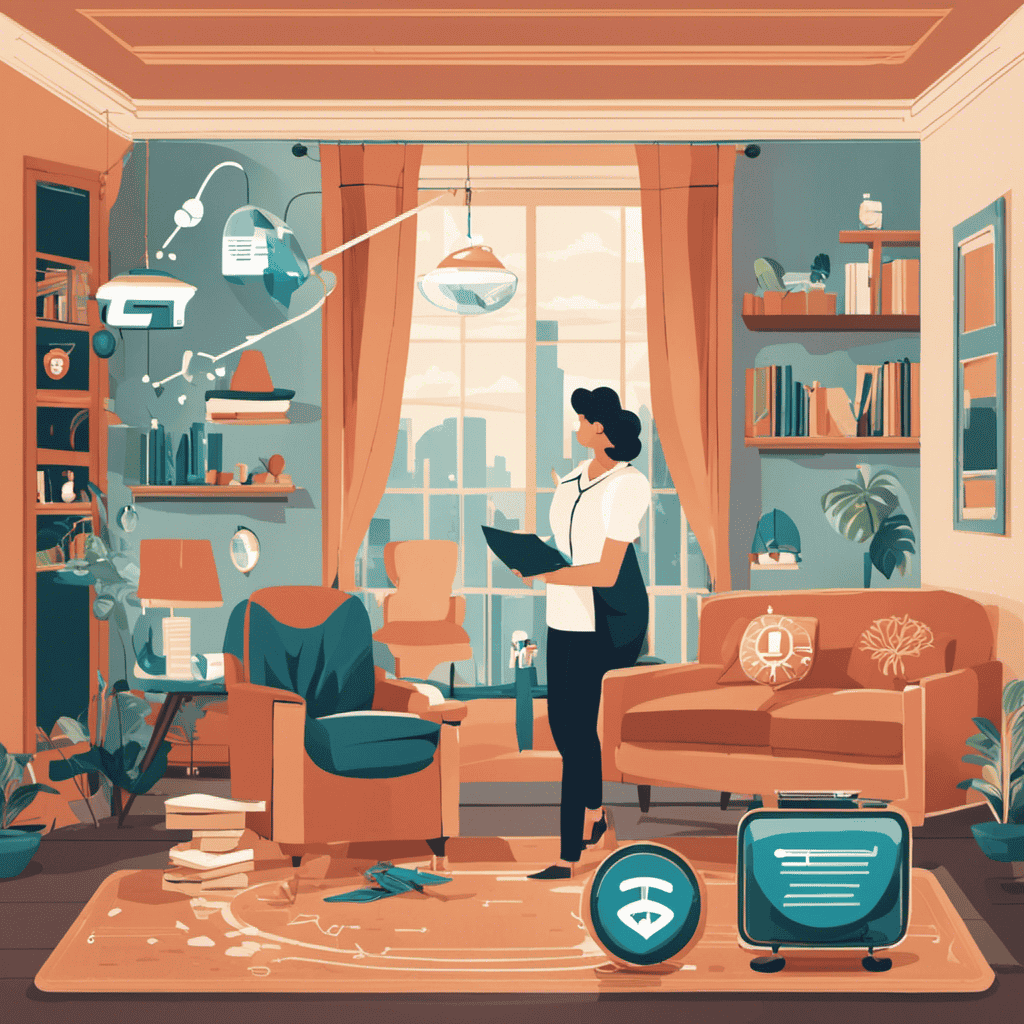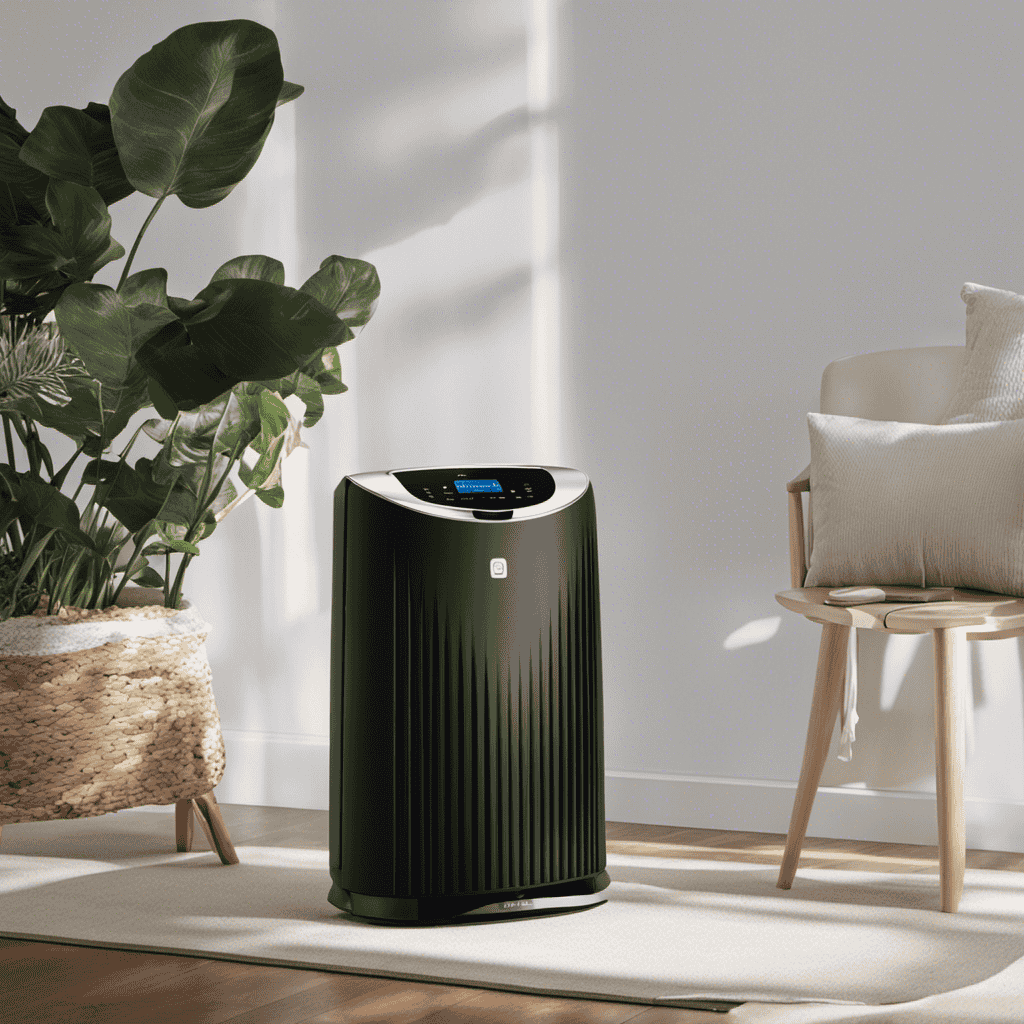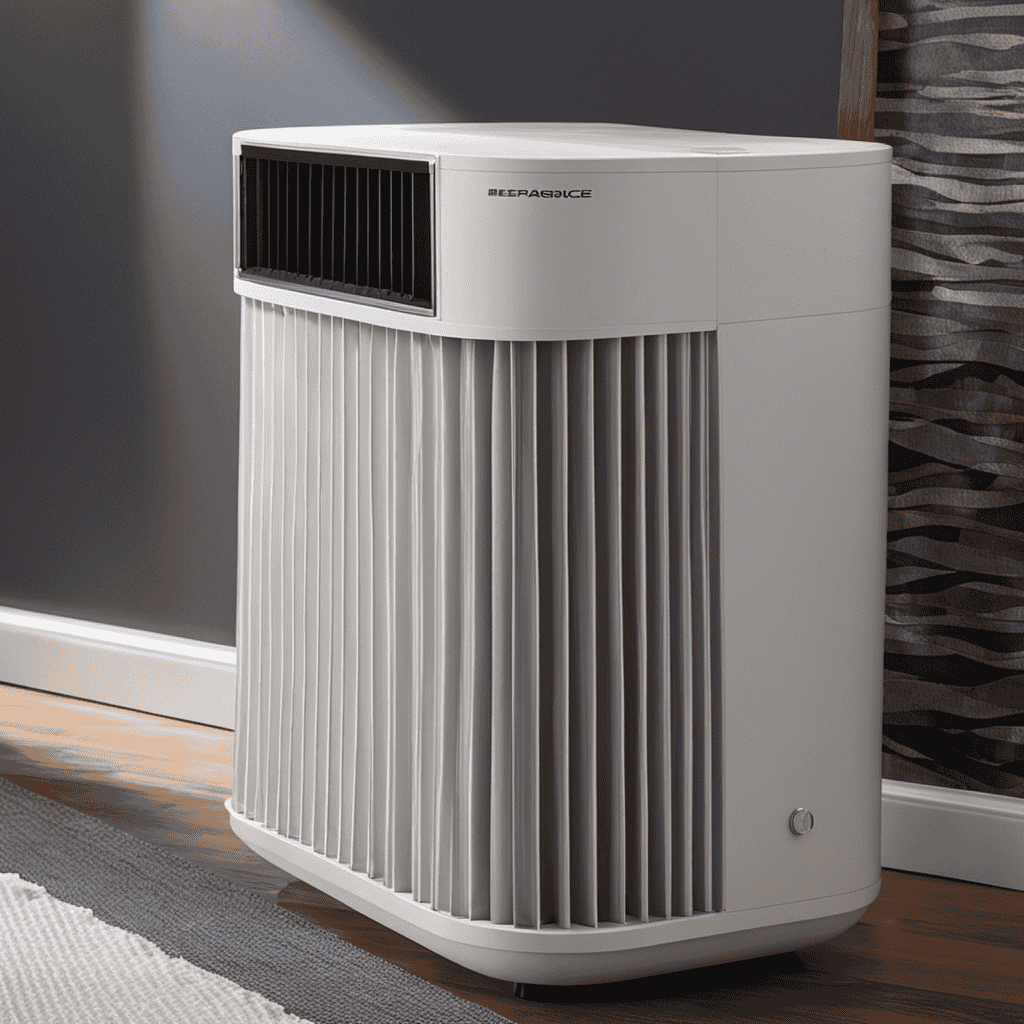As an allergy sufferer, I appreciate the significance of clean air for maintaining good health. This is why I am on a mission to explore ways to have insurance cover the expenses of an air purifier.
In this article, I will guide you through the steps necessary to determine if your insurance will pay for an air purifier, as well as provide tips for selecting the right purifier that meets insurance requirements.
So let’s dive in and demystify the process of getting insurance to pay for an air purifier!
Key Takeaways
- Review your insurance policy and discuss coverage options with your provider.
- Understand the insurance company’s definition of durable medical equipment or respiratory devices.
- Select an approved air purifier to increase the likelihood of coverage.
- Provide the necessary documentation to support your claim for reimbursement.
Types of Air Purifiers Covered by Insurance
If you want insurance to cover the cost, make sure you choose air purifiers that are approved by your insurance provider. Generally, insurance providers will cover air purifiers that are medically necessary and prescribed by a healthcare professional. These may include HEPA (High-Efficiency Particulate Air) filters, carbon filters, and UV-C light purifiers. It’s important to consult your insurance policy or contact your insurance provider to determine the specific types of air purifiers that are covered under your plan. Understanding the insurance claim process is also essential. You will need to gather all necessary documentation, such as a prescription from your doctor, invoices, and any other supporting documents required by your insurance company. By following the correct procedures and selecting an approved air purifier, you can increase the likelihood of your insurance covering the cost.
Now that you know which types of air purifiers are covered by insurance, let’s dive deeper into understanding insurance coverage for air purifiers.
Understanding Insurance Coverage for Air Purifiers
Understanding how insurance covers air purifiers can help you determine the extent of your coverage. It’s important to know that insurance coverage for air purifiers can vary depending on your specific policy and insurance provider. Here are some key points to consider:
-
Types of air purifier filters: Different air purifiers use different types of filters to clean the air. Insurance coverage may depend on the type of filter used in your air purifier. HEPA filters, for example, are commonly covered by insurance due to their effectiveness in removing allergens and pollutants from the air.
-
Insurance coverage for other home appliances: While air purifiers may be covered under certain insurance policies, it’s worth noting that not all home appliances are eligible for coverage. Insurance providers typically offer coverage for major appliances like refrigerators, washers, and dryers, but coverage for smaller appliances like air purifiers may be limited or require additional endorsements.
Understanding the specifics of your insurance policy and discussing your coverage options with your insurance provider can help you determine if your air purifier is covered and what steps you need to take to ensure proper coverage.
Steps to Determine if Your Insurance Will Pay for an Air Purifier
When it comes to determining if your insurance will cover the cost of an air purifier, there are two key factors to consider: coverage eligibility criteria and the required documentation for your claim.
Coverage eligibility criteria refers to the specific requirements that your insurance provider has in place for approving coverage for an air purifier. This could include factors such as the severity of your respiratory condition or the recommendation of a healthcare professional.
In order to successfully submit a claim for your air purifier, you will also need to provide the required documentation. This may include medical records, prescriptions, and a letter of medical necessity from your healthcare provider.
Coverage Eligibility Criteria
To determine if your insurance will cover the cost of an air purifier, you need to meet the eligibility criteria. Here are the coverage criteria you should consider:
-
Medical Necessity:
-
The air purifier must be prescribed by a healthcare professional as a necessary medical device.
-
It must be deemed essential for the treatment of a specific medical condition, such as asthma or allergies.
-
Insurance Reimbursement:
-
Check if your insurance plan covers durable medical equipment (DME) or respiratory devices.
-
Review your policy for specific coverage details and requirements.
-
Ensure that the air purifier meets the insurance company’s definition of DME or respiratory devices.
Required Documentation for Claim
You’ll need to gather all the necessary documentation to support your claim for reimbursement. When it comes to getting insurance to pay for an air purifier, there are specific coverage requirements and supporting evidence that you must provide.
First and foremost, you need to have a prescription from your doctor stating that an air purifier is medically necessary for your condition. This prescription serves as the primary piece of supporting evidence.
Additionally, you should gather any medical records that demonstrate your diagnosis or condition, such as test results or treatment plans. It’s also important to keep all receipts and invoices related to the purchase of the air purifier. These documents act as proof of the expense incurred.
Documenting Medical Necessity for an Air Purifier
When it comes to getting insurance coverage for an air purifier, there are two key points to consider: required medical documentation and insurance coverage criteria.
First, it is important to gather all necessary medical documentation that supports the need for an air purifier. This may include doctor’s notes, test results, and any other relevant documents that show the medical necessity.
Additionally, it is crucial to familiarize yourself with your insurance provider’s coverage criteria to ensure that your specific situation meets their requirements for coverage.
Required Medical Documentation
The insurance company needs a doctor’s note to cover the cost of an air purifier. To ensure your insurance coverage eligibility, here are the required medical documentation that you need:
-
Types of Air Purifiers:
-
High-Efficiency Particulate Air (HEPA) Filters: These purifiers are highly effective in removing allergens and pollutants from the air.
-
Activated Carbon Filters: Ideal for eliminating odors, chemicals, and volatile organic compounds (VOCs).
-
Coverage Eligibility Criteria:
-
Doctor’s Recommendation: Your healthcare provider must provide a detailed explanation of why an air purifier is necessary for your specific medical condition.
-
Medical Diagnosis: Clearly state your medical condition that requires the use of an air purifier.
-
Medical History: Provide a comprehensive history of your symptoms, previous treatments, and any allergies that contribute to your need for an air purifier.
Insurance Coverage Criteria
To be eligible for coverage, it’s important to provide the required medical documentation. Insurance coverage requirements vary depending on the type of insurance plan and the specific air purifier being requested.
Generally, insurance companies require a thorough evaluation from a healthcare professional, such as a doctor or allergist, who can provide a detailed explanation of the medical necessity for the air purifier. This documentation should include the patient’s medical history, any allergies or respiratory conditions they may have, and how the air purifier will directly benefit their health.
It’s also essential to follow the insurance claim process accurately, which typically involves submitting the necessary forms and supporting documents. By meeting these insurance coverage requirements and effectively navigating the claim process, the chances of getting insurance to pay for an air purifier increase significantly.
Tips for Selecting an Air Purifier That Meets Insurance Requirements
It’s important to select an air purifier that meets your insurance requirements. When it comes to selecting air purifiers, there are a few key factors to consider to ensure that your insurance coverage process goes smoothly.
-
Size and Coverage: Look for an air purifier that is suitable for the size of the room or area you want to purify. Insurance providers may have specific requirements on the maximum square footage coverage to be eligible for coverage.
-
Certification: Check if the air purifier you are considering is certified by a reputable organization such as the Association of Home Appliance Manufacturers (AHAM) or the Environmental Protection Agency (EPA). Insurance companies often require certified products for coverage.
How to Submit a Claim for an Air Purifier to Your Insurance
When it comes to submitting a claim for an air purifier to your insurance, there are several key points to consider.
First, you need to understand the eligibility requirements for insurance claims. This includes knowing whether or not your specific policy covers air purifiers and what conditions must be met in order to qualify for coverage.
Second, you should familiarize yourself with the required documentation process. This may involve providing receipts, proof of purchase, and any necessary medical documentation.
Finally, it’s important to be aware of any coverage limitations and exceptions that may apply to your claim. This could include things like coverage limits, pre-existing conditions, or specific brand restrictions.
Insurance Claim Eligibility
Although insurance eligibility for air purifiers can vary, it’s important to check your policy for coverage details. Insurance companies have different criteria when it comes to determining if they will cover the cost of an air purifier. Here are some important factors to consider:
-
Insurance claim process:
-
Contact your insurance provider to understand the necessary steps for filing a claim.
-
Keep documentation of your purchase, including receipts and any supporting medical documentation.
-
Insurance coverage restrictions:
-
Some policies may only cover air purifiers for certain medical conditions, such as asthma or allergies.
-
There may be limitations on the type or brand of air purifier that is covered.
-
Your insurance provider may require a prescription from a healthcare professional to approve the claim.
Required Documentation Process
To ensure your claim is processed smoothly, gather all necessary documentation such as receipts and medical records. Understanding the insurance reimbursement process is crucial to getting your air purifier covered.
When documenting medical necessity, it’s important to provide clear and detailed information to support your claim. Start by obtaining a prescription from your healthcare provider, stating the need for an air purifier due to a specific medical condition. Include any relevant test results or diagnoses that demonstrate the medical necessity.
Keep track of all expenses related to the air purifier, including the purchase price, installation costs, and any additional accessories. Take photos of the air purifier in your home, highlighting its placement and usage.
Coverage Limitations and Exceptions
In order to fully understand how to get insurance to pay for an air purifier, it is important to be aware of the coverage limitations and exceptions that may apply. While many insurance plans do provide coverage for durable medical equipment, such as air purifiers, there are often specific criteria that must be met. Here are some key points to consider:
-
Coverage Limitations:
-
Some insurance plans may only cover air purifiers for specific medical conditions, such as asthma or allergies.
-
There may be restrictions on the type or brand of air purifier that is covered.
-
Exceptions:
-
Certain insurance plans may have exclusions for pre-existing conditions, which could affect coverage for air purifiers.
-
Some plans may require prior authorization or a prescription from a healthcare provider.
Navigating the reimbursement process and understanding the appeal process is crucial when seeking insurance coverage for an air purifier. It is also important to thoroughly research and compare different insurance plans to find one that suits your needs. Understanding these coverage limitations and exceptions will help you prepare for potential challenges and increase your chances of getting insurance to pay for an air purifier.
Now, let’s explore the common reasons insurance claims for air purifiers are denied.
Common Reasons Insurance Claims for Air Purifiers Are Denied
One common reason insurance claims for air purifiers are denied is if the device is not deemed medically necessary. When it comes to insurance coverage for air purifiers, it is important to understand the types of air purifiers that are covered and the insurance claim process.
Most insurance policies will only cover air purifiers that are prescribed by a healthcare professional and deemed medically necessary for the treatment of a specific condition, such as allergies or asthma. It is crucial to consult with your doctor and provide all necessary documentation to support the medical necessity of the air purifier.
Additionally, understanding the insurance claim process is essential to ensure a smooth and successful reimbursement. This includes submitting the necessary paperwork, such as the prescription, medical records, and itemized receipts, and following up with your insurance company to ensure timely processing of the claim.
Appealing a Denied Insurance Claim for an Air Purifier
If your insurance claim for an air purifier is denied, you can consider appealing the decision. Appeals can be a lengthy process, but it is worth exploring if you believe your claim was unjustly denied.
To maximize your chances of success and maximize your coverage benefits, follow these steps:
-
Review your insurance policy: Familiarize yourself with the terms and conditions of your policy to understand the coverage you are entitled to.
-
Gather supporting documentation: Collect all relevant documents, including medical records, prescriptions, and any other evidence that supports the need for an air purifier.
-
Consult with a healthcare professional: Seek the advice of a healthcare professional who can provide a statement or letter explaining the medical necessity of an air purifier.
-
Seek assistance from a professional: Consider enlisting the help of a public adjuster or an attorney who specializes in insurance claims to guide you through the appeals process.
Understanding Insurance Reimbursement for Air Purifiers
To better understand how you will be reimbursed, review your insurance policy and consult with a professional who specializes in claims. Insurance reimbursement for air purifiers can vary depending on your specific policy and coverage. It’s important to familiarize yourself with the details of your policy to determine if air purifiers are covered and what the reimbursement process entails.
| Reimbursement Method | Benefits Covered | Coverage Limit |
|---|---|---|
| Direct Reimbursement | All Benefits | $500 |
| Reimbursement Claim | Specific Benefits | $300 |
| Out-of-Pocket Expense | Limited Benefits | $200 |
Resources for Finding Insurance Plans That Cover Air Purifiers
After understanding the ins and outs of insurance reimbursement for air purifiers, it’s time to explore resources that can help you find insurance plans that cover these devices. Finding affordable options and comparing coverage options is crucial to ensure you get the best deal for your needs. Here are some resources you can utilize:
-
Online Insurance Marketplaces:
-
These websites allow you to compare insurance plans from different providers and filter them based on coverage for air purifiers.
-
You can enter your specific requirements and preferences to find the most suitable options.
-
Insurance Brokers:
-
Brokers have extensive knowledge of different insurance providers and can help you find plans that cover air purifiers.
-
They can provide personalized recommendations and assist you in navigating the complex insurance landscape.
Frequently Asked Questions
Are There Any Specific Brands or Models of Air Purifiers That Insurance Companies Prefer?
Insurance companies may have preferences for specific brands or models of air purifiers based on features or technologies. Coverage for air purifiers can vary depending on an individual’s health condition or medical history.
Can I Purchase an Air Purifier Before Getting Approval From My Insurance Company?
Yes, I can purchase an air purifier before getting approval from my insurance company. However, it’s important to understand the terms of my insurance coverage and whether it includes air purifiers.
How Long Does the Process of Getting Insurance Approval for an Air Purifier Usually Take?
The process of getting insurance approval for an air purifier usually takes a few weeks. Common requirements include a doctor’s prescription and documentation of a medical necessity. It’s important to be thorough and persuasive in your application.
Is There a Limit to the Cost That Insurance Will Cover for an Air Purifier?
There may be cost limitations on what insurance will cover for an air purifier. It’s important to check your coverage eligibility and review your policy to understand the specific details and requirements.
Are There Any Alternative Options if Insurance Denies Coverage for an Air Purifier?
If insurance denies coverage for an air purifier, there are alternative options to consider. These may include negotiating with the insurance company, exploring other insurance policies, or seeking financial assistance through nonprofit organizations or government programs.
Can I Get Insurance to Pay for a Free Air Purifier?
Unfortunately, insurance typically does not cover the cost of a get free air purifier. However, there may be certain circumstances in which insurance could potentially help with the costs, such as if a doctor prescribes it for a specific health condition. It’s best to check with your insurance provider for more information.
Conclusion
In conclusion, navigating insurance coverage for air purifiers can be a complex process. However, with the right steps and documentation, it is possible to get your insurance to pay for it.
Remember, it is crucial to understand your insurance policy and document the medical necessity for an air purifier. Additionally, selecting a device that meets insurance requirements is important.
If your claim is initially denied, don’t give up. Appeal the decision and provide additional evidence to support your case. As the saying goes, "Where there’s a will, there’s a way."
Keep advocating for your health and the well-being of your loved ones.










